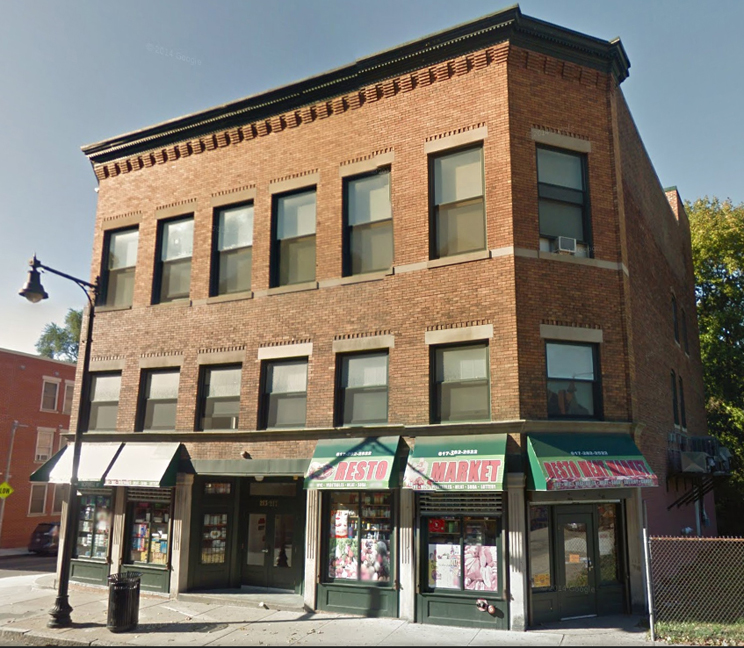
Dorchester Illustration 2519 Collins Building
The following is excerpted from the National Register description of the Collins Building, 213-217 Washington Street
In 1898, Charles F. Collins subdivided the land on either side of Kilton Street (now Norwell Street), between Washington Street and the railroad, and he decided to reserve the corner lot for a large mixed-use commercial building. In April 1898, Collins was granted a building permit for the construction of brick building, which was to contain stores, offices, and a function hall.
The Collins Building is typical of commercial buildings being constructed in urban centers at this time. It was not highly unusual to have a function hall in buildings of this type, particularly in town and neighborhood centers. Two examples of similar buildings are Palladio Hall and Hibernian Hall in Roxbury’s Dudley Square area (both NRIND), which both had retail space on the first floor, offices on the second, and a function hall above. It was an era when social clubs were abundant and sponsored greater numbers of public events, requiring large interior spaces. Many of the social clubs in urban centers were associated with particular ethnic groups, which had immigrated to this country in the late 19th and early 20th centuries, and established organizations that catered to customs brought from Europe.
Despite its Irish name, the early 20th century tenants of the Collins Building are representative of the large number of Jewish families who resided nearby at this time.
By 1900, Mt. Bowdoin had become a well developed middle-class neighborhood, with many fine single and multi-family dwellings. In 1910 about 300 Jewish families were living in the district that extends between Mt. Bowdoin and Franklin Park. In some sections of this district, the Jewish population was as high as 65%. Many of the earliest Jewish settlers in the neighborhood were members of the Beth El congregation, which met in a public hall on Washington Street near the railroad between the years 1908-1910. In 1910, the congregation, with a membership of about 60 families, began construction of a new synagogue on Fowler Street (two blocks west of the Collins Building). At the time, the Jewish Advocate reported, “the new synagogue, when erected, will be the first one in the Dorchester district.” The Boston City Directory of 1930 attests to the large number of Jewish families that had moved to the Washington Street/Bowdoin Avenue vicinity, an area previously dominated by the Irish.
When completed in 1898, the Collins Building held two stores at the first floor, several offices at the second floor, and a large function hall occupying most of the third floor. This division of space and use remained unchanged into the mid-20th century. The third floor was known as Bowdoin Hall until about 1910 when the name was changed to Mt. Bowdoin Hall. By 1918 the building was owned by Jacob Sidman who operated a grocery store there. Aside from Sidman, the earliest known occupants of the building include the Mt. Bowdoin Auto Repairing Company, operated by Mathew Freedman and Joseph Brenner of Chelsea. The Anthony Press, Great A & P Tea Company (grocery), Samuel Sidman shoes, and tailor Rubin Cohen were all tenants in 1930. By 1932 the function hall was known as the New Washington Auditorium. Jacob Sidman owned the building as late as 1933. By 1942 the hall was known as Silver Manor and was operated by Charles Rubin, a caterer with the company Louis Rubin & Sons. Rubin Cohen remained a tenant, along with the Oakes Ticket Company (printers); two other spaces were listed as “vacant” in city directories. By 1944 the property had been acquired by John Rubin. In 1953 the title passed from Robert Kelley to Helen S. Swartz. Her husband husband, Henry D. Swartz, had the legal occupancy changed to–allow for light manufacturing and the assembly of plastic covers for pillows, mattresses, etc. The third floor hall has remained a large open space since its construction and over the years has served as a meeting place and function hall for local organizations and residents. In the 1960s the building was owned by Hyman Karlsberg. The property was eventually taken by the City of Boston in 1980 for nonpayment of taxes.
The Collins Building was passed on to the private sector as part of city efforts to encourage revitalization in the neighborhood in 1998. It was rehabilitated using federal investment tax credits to continue its mixed use character, including retail stores at the first floor and residential apartments above.
